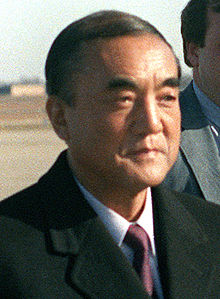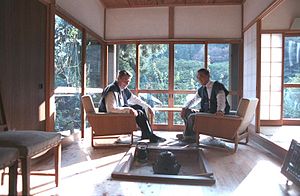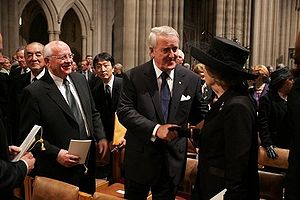- Yasuhiro Nakasone
-
Yasuhiro Nakasone
中曾根 康弘
Prime Minister of Japan In office
27 November 1982 – 6 November 1987Monarch Shōwa Preceded by Zenko Suzuki Succeeded by Noboru Takeshita Personal details Born 27 May 1918
Takasaki, JapanPolitical party Liberal Democratic Party Children Hirofumi Nakasone Alma mater Tokyo Imperial University Religion Shuuyoudan Houseikai[1] Yasuhiro Nakasone (中曽根 康弘 Nakasone Yasuhiro, born 27 May 1918) is a Japanese politician who served as Prime Minister of Japan from November 27, 1982 to November 6, 1987. A contemporary of Brian Mulroney, Ronald Reagan, Helmut Kohl, François Mitterrand, Margaret Thatcher, and Mikhail Gorbachev, he is best known for pushing through the privatization of state-owned companies, and for helping to revitalize Japanese nationalism during and after his term as prime minister. Nakasone is currently the oldest living Japanese prime minister.
Contents
Early life
Nakasone was born in Takasaki, in Gunma, a poor mountainous prefecture where his father was a lumber dealer.[2] He attended Tokyo Imperial University. During World War II, he was a commissioned officer and paymaster in the Imperial Japanese Navy.[2]
In 1947, he gave up a promising career in an elite government ministry to run for Parliament with the belief that in its postwar remorse, Japan was in danger of discarding its traditional values, according to a 2010 profile.[2] He entered the Diet of Japan as a member of the House of Representatives for the Democratic Party.[3] "As a freshman lawmaker in 1951, he delivered a 28-page letter to General MacArthur criticizing the occupation, a brazen move. The general angrily threw the letter in the wastebasket, Mr. Nakasone was later told. This stand established [Nakasone's] credentials as a right-wing politician."[2] He gained brief notoriety in 1952 for blaming Emperor Hirohito for Japan's defeat in the war. In 1955, at Nakasone's urging, the government granted the equivalent of 14 million dollars to the Agency for Industrial Science and Technology to begin nuclear power research.[1] Nakasone rose through the LDP's ranks, becoming Minister of Science in 1959 under the government of Nobusuke Kishi, then Minister of Transport in 1967, head of the Agency of Defense in 1970, Minister of International Trade and Industry in 1972 and Minister of Administration in 1981.
Prime minister
 President Ronald Reagan and Prime Minister Yasuhiro Nakasone having lunch at Nakasone's country residence in Japan in 1983.
President Ronald Reagan and Prime Minister Yasuhiro Nakasone having lunch at Nakasone's country residence in Japan in 1983.
In 1982, Nakasone became Prime Minister. Along with Minister of Foreign Affairs Shintaro Abe, Nakasone improved Japan's relations with the USSR and the People's Republic of China. Nakasone was best known for his close relationship with U.S. President Ronald Reagan, popularly called the "Ron-Yasu" friendship. He also visited President Corazon Aquino in a series of talks between the Philippines and Japan during a special state visit from 1986 to 1987, to provide good economic and trade relations, massive investor and tourist arrivals, and construction and rehabilitation programs. In domestic policy, Nakasone's most notable policy was his privatization initiative, which led to the breakup of Japan National Railways into the modern Japan Railways Group.
Nakasone also became known for having a nationalist attitude. He twice visited Yasukuni Shrine, after the controversial decision to enshrine 14 Class A war criminals was made in 1978. During his last term in office, he also gained notoriety among the various non-Japanese ethnic groups in Japan (particularly the sizeable Korean minority) for proclaiming that Japan's success was because it did not have ethnic minorities, like the US. He then clarified his comments, stating that he meant to congratulate the US on its economic success despite the presence of "problematic" minorities.[4] Due to this issue, Masayuki Fujio, the Minister of Education, had to resign in 1986.
In 1984 Nakasone visited China on the twelfth anniversary of Japan's diplomatic recognition of the People's Republic, for which the Chinese government arranged tours of China for 3,000 Japanese youth. On the trip, Nakasone's son was privately accompanied by the daughter of the Hu Yaobang, the General Secretary of the Communist Party of China. After the event, Hu was criticized by other members of the Chinese Communist Party for the extravagance and warmth of the event.[5]
Later political life
 Former Japanese Prime Minister Yasuhiro Nakasone (left) at the funeral of Ronald Reagan with former Soviet president Mikhail Gorbachev, with former Canadian Prime Minister Brian Mulroney and former British Prime Minister Margaret Thatcher.
Former Japanese Prime Minister Yasuhiro Nakasone (left) at the funeral of Ronald Reagan with former Soviet president Mikhail Gorbachev, with former Canadian Prime Minister Brian Mulroney and former British Prime Minister Margaret Thatcher.
Nakasone was replaced by Noboru Takeshita in 1987, and was implicated, along with other LDP lawmakers, in the Recruit scandal that broke the following year.
Although he remained in the Diet for another decade and a half, his influence gradually waned. In 2003, despite a fight,[6] Nakasone was not given a place on the LDP's electoral list as the party introduced an age limit of 73 years for candidates in the proportional representation blocks. This ended his career as a member of the Diet. The move was widely seen as a blunt and effective attack by Junichiro Koizumi on the old guard LDP leadership.
Nakasone's son, Hirofumi Nakasone, is also a member of the Diet; he served in the cabinet of Keizō Obuchi as Minister of Education and was Minister of Foreign Affairs in the cabinet of Taro Aso.
In early 2010, "aware of his status as one of the few leaders revered across Japan’s suddenly fractured political landscape" and the country's "most revered elder statesman," Nakasone launched a series of interviews to address the direction of prime minister Yukio Hatoyama's government. In a profile at that time, Hatoyama's "inexperienced left-leaning" government was seen as "challenging Japan’s postwar political order and its close relationship with the United States." As well, the LDP was "crumbling into disarray" in the wake of Hatoyama's victory. In the profile, Nakasone described the moment "as a national opening on par with the wrenching social and political changes that followed defeat in the [world] war [and] praised the appearance of a strong second political party as a step toward true democracy. "'Being knocked out of power is a good chance to study in the cram school of public opinion,'" he was quoted as saying of the LDP. He "faulted Mr. Hatoyama for giving Washington the impression that [Hatoyama] valued ties with China more than he did those with the United States. 'Because of the prime minister’s imprudent remarks, the current situation calls for Japan to make efforts to improve things,' he said. The [Japanese] relationship with the United States is different from that with China, he said, because 'it is built on a security alliance, and not just on the alliance, but on the shared values of liberal democracy, and on its shared ideals.'" And relative to another high-profile current source of friction between Japan and the United States, Nakasone said "'Problems like Okinawa [and the American military base there] can be solved by talking together.'"[2]
Political offices Preceded by
Zenko SuzukiPrime Minister of Japan
1982–1987Succeeded by
Noboru TakeshitaPreceded by
Sōsuke UnoMinister of State, Head of the Administrative Management Agency
1980–1982Succeeded by
Kunikichi SaitōPreceded by
Kakuei TanakaMinister of International Trade and Industry
1972–1974Succeeded by
Toshio KōmotoPreceded by
Tatsunosuke Takasaki
Shirō KiuchiMinister of State, Head of the Science and Technology Agency
1959–1960
1972Succeeded by
Masuo Araki
Kazuo MaedaPreceded by
Kiichi AritaMinister of State, Head of the Japan Defense Agency
1970–1971Succeeded by
Keiichi MasuharaPreceded by
Takeo ŌhashiMinister of Transport
1967–1968Succeeded by
Ken HaradaDiplomatic posts Preceded by
Helmut KohlChair of the G7
1986Succeeded by
Bettino CraxiParty political offices Preceded by
Zenkō SuzukiPresident of the Liberal Democratic Party
1982–1987Succeeded by
Noboru TakeshitaPreceded by
Susumu NikaidōSecretary-General of the Liberal Democratic Party
1974–1976Succeeded by
Tsuneo UchidaPreceded by
Zenkō Suzuki
Masumi EsakiGeneral Council Chairman of the Liberal Democratic Party
1971–1972
1977–1978Succeeded by
Zenkō Suzuki
Kuraishi TadaoPreceded by
Himself (Co-chairman)
Umekichi Nakamura (Co-chairman)
Yoshio Sakurauchi (Co-chairman)Chairman of Shinsei Dōshikai (Nakasone faction)
1968–1978Change of official faction name New title
Change of official faction nameChairman of Seisaku Kagaku Kenkyūjo (Nakasone faction)
1978–1990Succeeded by
Michio WatanabeHouse of Representatives of Japan New title
New districtRepresentative for Gunma's 3rd district (multi-member)
1947–1996
Served alongside: Mitsuhei Obuchi, Takeo Fukuda, Tsuruo Yamaguchi, Keizō Obuchi, Yasuo Fukuda, numerous othersDistrict eliminated New title
Introduction of proportional votingRepresentative for the Kita-Kantō PR block
1996–2003Succeeded by
-References
- ^ 上之郷, 利昭 (1994). 教祖誕生. 講談社文庫.
- ^ a b c d e "Japan’s Elder Statesman Is Silent No Longer" by Martin Fackler, The New York Times, January 29, 2010 (on Jan. 30, 2010 p. A11 of the NY ed.).
- ^ The Senkyo, 23rd election of the House of Representatives, Gunma's 3rd district
- ^ Nakasone's World-Class Blunder by Ezra Bowen, Time magazine, June 24, 2001.
- ^ Lee, Khoon Choy. Pioneers of Modern China: Understanding the Inscrutable Chinese. Singapore: World Scientific Publishing. 2005. p.311. ISBN: 9812564640.
- ^ The Japan Times, October 24, 2003: "Single-seat constituencies offer refuge for LDP elders who refuse to retire"
- Hood, Christopher P. (2001). Japanese Education Reform: Nakasone's Legacy. London: Routledge. ISBN 0-415-23283-X.
Prime Ministers of Japan (List) 
H. Itō · Kuroda · Sanjō · Yamagata · Matsukata · H. Itō · Kuroda · Matsukata · H. Itō · Ōkuma · Yamagata · H. Itō · Saionji · Katsura · Saionji · Katsura · Saionji · Katsura · Yamamoto · Ōkuma · Terauchi · Hara · Uchida · Takahashi · To. Katō · Uchida · Yamamoto · Kiyoura · Ta. Katō · Wakatsuki · G. Tanaka · Hamaguchi · Shidehara · Hamaguchi · Wakatsuki · Inukai · Takahashi · Saitō · Okada · Gotō · Okada · Hirota · Hayashi · Konoe · Hiranuma · N. Abe · Yonai · Konoe · Tōjō · Koiso · K. Suzuki · Higashikuni · Shidehara · Yoshida · Katayama · Ashida · Yoshida · I. Hatoyama · Ishibashi · Kishi · Ikeda · Satō · K. Tanaka · Miki · T. Fukuda · Ōhira · M. Itō · Z. Suzuki · Nakasone · Takeshita · Uno · Kaifu · Miyazawa · Hosokawa · Hata · Murayama · Hashimoto · Obuchi · Aoki · Mori · Koizumi · S. Abe · Y. Fukuda · Aso · Y. Hatoyama · Kan · Noda
 Italics denote acting Prime MinistersCategories:
Italics denote acting Prime MinistersCategories:- 1918 births
- Living people
- Cold War leaders
- People from Takasaki
- Prime Ministers of Japan
- University of Tokyo alumni
- Japanese military personnel of World War II
- Liberal Democratic Party (Japan) politicians
- Members of the House of Representatives of Japan
- Democratic Party (Japan, 1947) politicians
Wikimedia Foundation. 2010.
